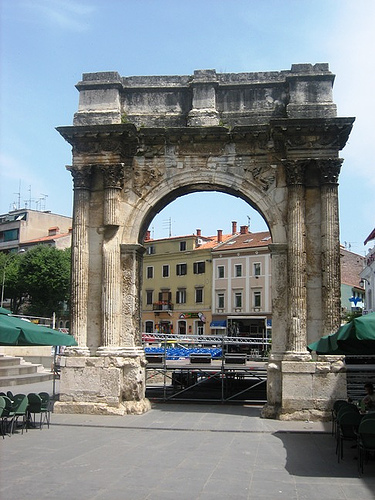

Location: Ulica Sergijevaca
Constructed: 27 BC
The arch of the Sergii (often called The Golden Gate),
an ancient Roman arch in Pula, Croatia. It was erected in memory of
three members of the Sergius family, especially Lucius Sergius Lepidus,
a Tribune who served in the Roman Legion, which took part in the Battle
of Actium, so it is assumed that the arch was built between 29. and 27.
years BC The Sergii were a powerful family in the colony, and retained
their power for centuries.
In the monument is carved the name of
salvia Postuma, who paid for the construction (de sua pecunia), and as
she was married to the family of Sergius, erected it in honor of
probably her husband, Lucia Sergius Lepidus, his father Lucia Sergius
and uncle Gnaeus Sergius. It is decorated in the late Hellenistic style,
with oriental influences. The bas-relief on the arch depicts a
horse-drawn war chariot.
The Arc de Triomphe attracted the
attention of many artists, including Michelangelo's pupil Bastiano De
Sangallo, who immortalized it with a drawing. It probably served as an
antique role model for one of his masterpieces. The drawing is today
kept in the wicar Museum of the French city of Lille.
The frame of the archway consists of massive pilasters-supports built of large stone blocks that are expanded in the lower parts, so that they also make the bases of columns that revive the vertical pilasters, arch supports from the front and back. The opening ends with a vault formed by wedge-shaped blocks, and it is connected to the whole by a three-part architrave on which the frieze that encloses the archway continues. Above the Frieze there is a wreath and a three-part Attica (architecture) which was also the base of the statues of the three Sergians to whom the monument was erected. The exceptionally rich decoration of the Arch is carved in Oriental Hellenistic manner. The pilasters are enlivened and dissected by slender columns with sumptuous Corinthian capitals, on the City side the pilasters are decorated with plant decoration of twisted branches with acanthus leaves. The inner rocks of the vaulted opening are decorated with grape vine stems, which grow from Acanthus leaf pods at the bottom of the base of the arch. The vault of the opening is castered and decorated with large rosettes. The center field is decorated with a depiction of an eagle with spread wings fighting a snake, while in the fields of the vault is carved a depiction of dolphins, sphinxes and Griffons. On the city facade of the monument in high relief above the arch are placed opposite depictions of winged Victorias wearing garlands, and there are also paths adhering to festoons with bucarnias. On the cornice component are carved and the two-aisles opposite placed and facing the center of the Frieze. In the central place, above the vault of the Arch is carved the inscription of its installation: SALVIA POSTUMA SERGI de SUA PECUNIA. The shorter sides of the arch Frieze show Roman and barbarian military equipment. Above the Frieze is a richly decorated wreath dissected by consoles and cassette fields above the consoles. The Arc de Triomphe has not only a triumphant and honorable character.
Benefactress, the Sergians, Your Grace and divine protection
The
eight-meter-high arch was commissioned by Salvia Postuma Sergia after
the Battle of Actium (31 BC) as a monument to three of her male
relatives and financed from private funds of the wealthy woman, as it is
expressly stated on the Sergier arch: de sua pecunia.
The three
male relatives of the founder and she herself, who as four, originally
five sculptures – if the fifth sculpture was depicted, it is no longer
possible to determine – only stood on the attic, how traces appeared on
its surface, are listed by name.
It is unclear whether Salvia
Postuma Sergia was the wife or the mother of the most prominent of the
three men, namely Lucius Sergius Lepidus jr., who had been an aedil and
military tribune of the 29th Legion. His sculpture originally stands in
the middle of the arch and was the only one that was larger than life.
Eagles on the lower side of the Sergier arch
The founder was
free of any manus by the death of her male relatives and thus she had
the enormous fortune of the family. However, this was only possible
since the lex Iulia de maritandii ordinibus, which allowed upper-class
women, if they had given birth to three or four children, to freely
dispose of the inherited wealth. Within the framework of a rule by
freedom (yourgetism), the monument represents an early example of
feminine yourgeticism.
Since the monument was also dedicated to
the goddess Minerva, it was supposed to invoke her protection for the
city. They were able to do this task particularly well when their
monument was erected near the entrance to the city, as Emperor Augustus
had also practiced in some cities. To the left and right of the writings
are two men, perhaps as an allusion to Helios and Selene, as sun and
moon, to the beginning and end of life. The eagle can be considered a
symbol of apotheosis. The men depicted were "heroes of the city".
The unusual arch was arranged by Scipione Maffei to plead for the
arch to be brought to Venice for teaching purposes.